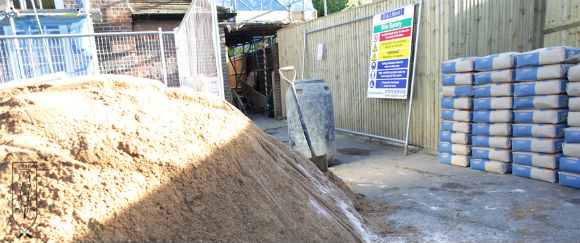
A Practical Guide to Screed Testing: What Do the Experts Say?

A Practical Guide to Screed Testing: What Do the Experts Say?
Storage and Handling of Cement and Aggregates

One of the most important factors for high quality, cost-effective screeding is the efficient use of materials. Portland cement, the primary ingredient of cementitious screed is a quality assured manufactured product. But being chemically reactive with water, it has to be stored, transported and handled carefully, to preserve its quality and avoid wastage.
Cement
Things to remember:
1. Keep cement protected from dampness and moisture
Cement is highly sensitive to moisture, and it hardens to forms clumps when exposed to water or dampness. While storing cement bags at the site it is important that they are kept protected from wetness (rain, flooding, leakages etc), as well as dampness (moisture present in the air). The cement bags should be stored in a dry and enclosed structure, protected from rains and moisture and the stacked cement bags should be kept covered with waterproof sheets or tarpaulin.
2. Do not place cement bags directly on concrete or wood floors
To protect the bags from dampness rising from the ground, it is ideal to store the bags on a raised surface with an impermeable plastic sheet underneath.
3. Handle cement bags carefully
While handling the cement bags:
- Make sure the cement bags are not dropped. This can weaken and damage the packaging.
- Roll the cement bags over before lifting. This helps to loosen up the cement, and reduces the chances of the bag from splitting.
- When carrying individual cement bags, do not carry them by holding at the ends. Make sure the bag is held by supporting on the underside. This will help to prevent the bag from sagging in the middle and splitting, and also reduce the strain on the shoulders and back.
- Make sure the cement bags are not stored upright or on their sides, but laid flat with their broad sides down.
4. Keep cement bags protected during transportation.
- To prevent the bags from being punctured or damaged, make sure any sharp objects are removed from the vehicle before loading the bags
- When loading the cement bags, make sure they are stacked in alternate directions, covered with a tarpaulin or water proof sheet and tied down securely to prevent movement during transport.
5. Store cement bags separately
Do not store the cement bags with fertilizers or other products, as any contamination can affect the quality and performance of the screed.
6. Provide adequate ventilation when stored in pallets in warehouses
When storing cement bags in warehouses, make sure adequate ventilation is provided to avoid the buildup of damp air.
7. Rotate cement bags on a first in basis
The strength of cement deteriorates with time so rotate the stock to ensure usability. Check the manufacturers’ date and use the oldest stock first.
8. Store leftover cement carefully
Cement left in torn or opened bags should really be used first, but ideally they should be re-bagged in plastic bags or heavy duty garbage bags and the mouths sealed securely with string or tape.
Aggregates
About 75% of a screed mix is constituted of aggregates. The quality, size and shape of the aggregates influences the strength of the finished concrete, and adequate care should be taken while storage and handling to avoid contamination. It is also important to keep the aggregates protected from rains and moisture, as the water content can affect the mix design of the screed.
Things to remember:
- Do not heap different sizes of aggregates in such a way that they overflow into each other. This can cause different sized aggregates to get mixed, making it difficult to obtain the expected mix design.
- Keep the aggregate piles covered with plastic sheets or tarpaulin.
- Store the aggregates on clean, hard ground away from trees to avoid contamination.

WHY SCREED TESTING CAN SAVE YOUR PROJECT TIME AND MONEY?
Download your free Practical Guide to Screed Testing here.






